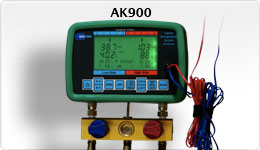AK900
Introducing the AK900.
The AK900 with Manifold is now available from the Digi-Cool Store for just $299.00.
OUT OF STOCK
Amazing performance at an awesome price!
We built one of the world’s first digital refrigeration system analyzers in 1989. Now, we are bringing you the next stage in digital HVAC evolution—the AK-900.
With patented ‘bar-graph technology,’ extreme durability torture tests, and an intuitive ‘tech-focused design’ — the AK-900 is made to help you better understand the loads of data, see the importance of small pressure fluctuations, and better monitor system performance.
Intuitive trouble-shooting
Smart design is based around the needs of techs in the field. From a large LCD display, ‘no toggle’ screen, to user-friendly real time updates, the AK-900 gives you far-reaching refrigeration analysis in a highly readable format.
Deadly accurate. And can take a beating.
Accuracy is why digital beats analog. And the AK-900 kills in this category with .5%. Plus, our famous torture tests show exactly how tough and reliable our tools are. Drown it in rain, crush it with a truck–the AK-900 will work hard for years and years.
Professional tool.
Full support.
We know Digi-Cool products aren’t the cheapest. But we don’t take shortcuts. You get full customer support. Affordable upgrades. And a strong, one-year guarantee.
 Download DRSA AK-900 Data Sheet
Download DRSA AK-900 Data Sheet
 Download DRSA AK-900 User Manual
Download DRSA AK-900 User Manual
| Question: | BTD-1000 Superheat / Subcool measurement | |
| Answer: |
Using the BTD-1000 Analyzer, the process of calculating system superheat and subcooling is much easier than before. All you need is a temperature sensor.
Suction Superheat: Discharge Superheat: Subcool: Note: for zeotype blends or pure refrigerants, the dew and bubble points will be the same. |
| Question: | Change btwn ASHRAE designation and traditional trade number displays | |
| Answer: |
To change between the two types of labels, follow the steps below:
With power off, press and hold “R-?”. Press “PWR” momentarily. The unit should power on and the type of labels shown should be different than before. Note that for some refrigerants, there is no distinct trade number, like R-134A. In that case, it is displayed as “134”, without “R”. |
| Question: | Charging with DRSA-1100 | |
| Answer: |
The proper way to charge a system is by superheat or subcooling (SH/SC). Based on the equipment manufacturer’s SH/SC tables and ambient conditions, the technician has a target SH or SC. The DRSA-1100, by automatically showing the superheat in real-time, can speed up charging by allowing you to quickly see if the charge is right. Depending on how good the technician is, this can save a lot of time on installations
|
| Question: | Measuring Glide |
| Answer: |
The glide of a blended refrigerant operating in a system is the difference between its bubble and dew temperatures at a certain pressure. To check using the analyzer, cross connect the gauges so both the low and high sides ports read the same pressure. Make sure to disconnect the other system conection first at the manifold. The glide is the difference between the dew and bubble points displayed. Note that the two pressure readings may not agree exactly due to accuracy tolerance.
|





